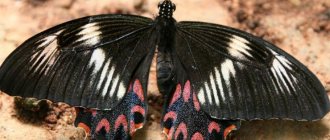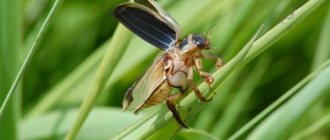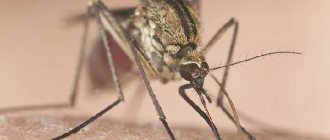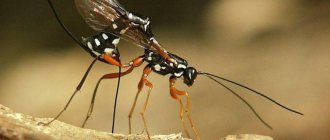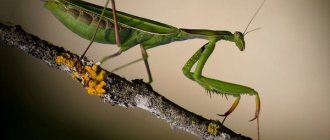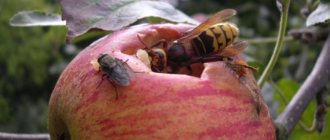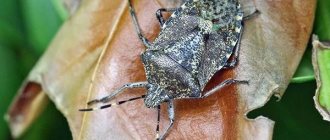The book false scorpion lives in nature, but now there are fewer and fewer such natural habitats, so it has moved into houses and apartments. Usually these insects live in damp, dark and secluded places, for example, under a stone, in a cave, in a tree post and other places hidden from human eyes. That’s why they are rarely seen in the wild, but the appearance of a bookish specimen in an apartment throws many into fear, panic and the search for a saving slipper or broom. How dangerous is a false scorpion for humans?
Book false scorpion as part of wildlife
This insect cannot be called a scorpion due to the fact that it is more like a spider, especially without poisonous glands. The abdominal part is more reminiscent of a tick, but the walking legs and feeding method are the spitting image of a spider. The body of the false scorpion is very small - approximately 3 mm, and the largest book "scorpion" was 12 mm in size. This already makes you relax, what can this little guy do?
The weapon of the spider-like insect is chelicerae, claws that allow this predator to attack the victim, pierce it and suck out all the life-giving moisture. It sounds scary, but people are not included in its diet.
An insect's senses are not developed in the same way as a human's, and therefore the claws of a false scorpion serve as all sense organs at the same time. In fact, because of these claws, the spider-like bug was menacingly nicknamed the scorpion. Their size is the same as the body, and therefore it is difficult to ignore this weapon. However, unlike scorpions, its false relatives do not have a tail or that very poisonous sting. So the book insect does not justify its comparison with the sporpion, which is dangerous to human life.
Tartarocreagris texana
Author:
The photo shows a resident of the American state of Texas. They lived in two caves in Travis County. American naturalists have conducted studies stating that the species is on the verge of complete extinction.
Belongs to the large family Neobisiidae. All life activities, nutrition, and reproduction take place in complete darkness. Therefore, they lack eyes, as well as a tail and sting.
It uses claws to capture small arthropods, which form the basis of its diet. These are small arachnids that do not grow more than 4 mm.
How do book insects reproduce?
This species of arachnid reproduces once a year through sexual intercourse. This is not just some kind of intercourse, but a whole ceremony. Males circle around their chosen ones in a dance of love, moving their abdomen from side to side and dancing with their walking legs.
After the babies are born, the mother will die, sacrificing herself to feed the little bugs. Her children will also be able to become parents in one year, and the life expectancy of book scorpions is approximately three years.
Ayyalonia dimentmani
This species is named after the Israeli naturalist Dr. Chanan Dimentman. But the name of the genus was given at the place of their first discovery - Ayalon Cave.
Small in size, only 2.5–2.8 mm. There is no body pigmentation. During evolution, this cave species lost its organs of vision. But he easily navigates in the darkness of a limestone cave using his senses of touch.
It was first discovered and described by the famous arachnologist from Serbia, Bozidar Kurcin. In 2008, a new species was included in the classification of false scorpions.
By the way, on our website most-beauty.ru there is fascinating material about the TOP 10 most poisonous scorpions on the planet.
What are they?
In houses and apartments, false scorpions choose to live in a place where it is quiet and calm, as well as a lot of dust and all kinds of living creatures. These are bookcases, shelves with various papers and other storage areas for the remains of human activity and their domestic insects. That is, if there is a place where a rag for wiping dust has reached it, it means that there is definitely this carrier of threatening claws there. It is very, very difficult to notice a false scorpio. This usually happens during spring cleaning, when things are carefully moved from one place to another.
Another favorite room of bookish individuals is the bathroom. Here, most often, the lights are turned off, there is moisture, which means there is something to profit from. In addition, rarely does anyone immediately wash out the bath with bleach after a shower, and there are various pieces of skin left on which small insects converge. It is difficult to notice claws in the bathroom, but if you look closely immediately after turning on the light, you can see some movements - most likely these are false scorpions running away from the prying eyes of the apartment owner.
The benefits and harms of false scorpions
In nature, these insects feed on fly larvae, ticks and small spiders; the diet of the book species is not very different. False scorpions living at home exterminate any small insects, these include book and dust louse, small bugs and mites. Thus, false scorpions can be called orderlies of bookshelves, because they destroy a lot of pests, which helps keep things in order, and protects people from allergic reactions and other troubles.
However, there are situations when the number of such insects increases rapidly, which causes a lot of concern to the residents of a small apartment. Although book dwellers will not bring any harm to humans, since they do not have poisonous reserves and do not emit toxic substances, they can be annoying with their mere presence. In this case, it is necessary to prevent the occurrence of insects in the house.
What to do when meeting?
- If you see a false scorpion, calm down, it is not dangerous. Most likely he is also scared, frozen and pretending to be dead. Play along with him, turn off the light and enter the room after 1 minute. The book scorpion will no longer be visible.
- The false scorpion moves slowly and, if you decide to kill it, it can show sprinting abilities and try to escape. And the false scorpio can run sideways, back and forth, so you can expect anything from him.
- If a false scorpion bites, then you just need to lubricate the area with some kind of disinfectant. It does not have any poison, it cannot cause burns or allergies, and therefore there is no point in panicking and nervously calling an ambulance.
How dangerous are false scorpions?
People usually think about this after an energetic hunt with complete destruction of slippers and other improvised objects. And it turns out that the bugs are completely peaceful, frightening only in appearance. Logically speaking, tiny size and food preferences do not interfere with living peacefully next to people.
On the contrary, false scorpions bring benefits to humans, performing the functions of household orderlies:
- They destroy dust mites and book lice, the secretions of which become a torment for allergy sufferers.
- They actively resist house ants, killing them in a spider-like manner.
- They eat small bugs that appear in cereals during long-term storage.
- They get rid of dust accumulations, which become a haven for pathogenic microorganisms.
Given the method of reproduction of these insects, the invasion of false scorpions does not threaten apartments. Given their extremely small size, not a single thing suffers from tiny pest hunters. The air in a human home becomes cleaner, getting rid of microparticles of dead skin and allergenic waste products of the smallest insects.
Cons from the neighborhood
Although false scorpions do not attack people, they can cause deterioration in health, and particles from their waste products can cause allergies in people with increased sensitivity. If you accidentally touch a false scorpio, he will defend himself. Once in the hands of a person, it can bite.
In a large apartment, meeting an insect is an unlikely event. But in a cramped one-room environment, false scorpions are much more likely to catch a person’s eye. Especially with the annual increase in population. For nervous and impressionable housewives, their frightening appearance can become a source of serious stress. Many generally cannot stand insects and consider them a sign of dirt in the house and the carelessness of the housewife who breeds evil spirits.
How to disperse peacefully when meeting
An accidental collision in territory that an insect and a person consider to be theirs should not cause panic. After all, this is not a real poisonous scorpion; there is no danger of being stung by a dust mite hunter. Most likely, the false scorpio will also be scared. Before he can escape, he will probably pretend to be dead.
If you play along with it and turn off the light, then when you turn it on again a minute later, the insect will no longer be visible. Although these claws usually move slowly with the clumsiness of sea crabs. But under the threat of death from a slipper or a broom, they can turn on an unprecedented speed and run sideways or backwards, shaking their claws threateningly.
If it accidentally ends up in your hand, it can bite. But it will not release any poison into the wound. Therefore, instead of calling an ambulance, it is enough to simply lubricate the wound with any disinfectant.
How to fight?
- Clean your home more often, do not create ideal conditions for their habitat - do not allow dust and open damp areas.
- Ventilation of the house should be regular, and the floors should be washed not with plain water, but with the use of detergents.
- From time to time it is necessary to carry out special measures to combat domestic insects.
The false scorpion is not dangerous to human life and is even quite useful in household use. But if you still don’t like insects, then you need to reconsider your general cleaning schedule.
Garypus beauvoisi
A large pseudoscorpion has chosen the Mediterranean coast. They grow up to 7 mm. It is easy to identify by its characteristic color.
The body is reddish in color, but the head, limbs and claws are red. Meeting such a creature can be frightening, as they strongly resemble scorpions. Note that poisonous scorpions are also common in this region of the planet.
Hides in algae deposits, which are abundant on the coast. Adapted to withstand the ebb and flow of the tides.
Fighting methods
- Pour boiling water over the area where insects accumulate;
- lay out the traps in the form of wet rags on which the two-tails will be collected, then destroy the traps;
- dig the area deeply in the fall, this will help reduce the number of unwanted guests next year;
- Earwigs are afraid of the smell of vinegar; you need to place sponges soaked in vinegar on the area for washing dishes.
In the house
- Thoroughly clean the room, plug up all the cracks and eliminate all pipe leaks so that there are no wet places in the house that are so loved by earwigs;
- spread food baits around the house (bran, hard-boiled egg yolk) mixed with an insecticidal agent or regular boric acid;
CAREFULLY! Place baits in places inaccessible to children and animals. https://www.youtube.com/embed/ocpPwRdR6IU
in case of large-scale invasions of two-east, it is necessary to call the sanitary and epidemiological service.
That's all the information you need about all the advantages and disadvantages of earwigs. The appearance of this insect is quite unpleasant, which may be why there are so many terrible rumors about earwigs.
If you find an error, please highlight a piece of text and press Ctrl Enter.
Is it worth fighting book false scorpions?
Since domestic false scorpions are not dangerous and rarely reproduce in large numbers, it is not worth exterminating such neighbors, because they feed on dangerous insects, thereby protecting your home from small parasites. However, in nature there are individuals similar to the book pseudoscorpions; these can be ticks and spiders that can bite painfully and leave behind burns and blisters. These are the types of individuals that should be dealt with, and very carefully.
The best option would be to prevent the occurrence of unwanted insects in the apartment:
- firstly, regularly carry out general cleaning in the house, get rid of garbage, do not store old newspapers and magazines, do not crowd corners with things;
- secondly, ventilate the premises as often as possible and carry out wet cleaning using chemicals;
- thirdly, periodically treat areas under the sink and behind cabinets with dichlorvos or special solutions against household pests.
Such basic rules of room hygiene will help you prevent the appearance of many unpleasant insects and keep your apartment tidy and clean.
Reproduction of false scorpions
A black beetle with claws in front is building itself a shelter from scrap material, in the apartment it is leftover paper. They are glued together with cobwebs. Molting and egg laying take place there. In the wild, the building material is dry vegetation, moss, and leaves. The beetle overwinters in a cocoon.
False scorpion
Pseudoscorpions become sexually mature at the age of 1 year, and the imago lives for another 2 years. After fertilization, the eggs inside the female take a month to develop. Then she pushes them into a special chamber connected to the ovary and continues to drag them along with her.
The number of eggs in different types of false scorpions differs - from 3 to 50 pieces. The first generation larvae feed on the yolk secreted by the ovaries, grow, increase in size, break through the sac, and crawl out.
Externally, the larva is similar to the imago, but the chitinous cover is white, soft, and the pedipalps are short. Until the first moult, the nymphs continue to live on the female’s body and feed on egg yolk. Then they crawl to the side, form a cocoon, and change the chitinous cover to a darker, harder one. During the entire period of maturation, the nymph molts 6 times; at the last stage, the genitals appear.
Interesting!
Before mating, the male performs a mating dance and squirts seminal fluid into a special sac. He approaches the female, she inserts this pouch into her genitals, the male begins to shake her with all his might so that everything pours out inside.
Varieties
The book pseudoscorpio is a real book lover, he lives on bookshelves, in folders with
papers, under poorly glued wallpaper, in libraries, archives. You can find these insects by sweeping the dust. Compared to the size of the body, the scribe's claws look very large and massive. The book false scorpio is slow, but moves equally well in any direction. He lives in almost every house or apartment, but due to his secretive lifestyle, he does not catch the eye.
The book pseudoscorpion eats mainly small insects from the order of hay-eaters (for example, the book louse). Hay eaters live in the same place as false scorpions: in books, libraries, archives and other papers. Also, the book false scorpion is not averse to feeding on thyroglyphoid mites, small bugs and other small insects that live in our apartments. So this insect brings a lot of benefits to you and me.
What is an air ionizer and how it works
What is the benefit of an air ionizer in a room or office? To understand this, you need to know the principle of operation of the device.
An ionizer is a device with special equipment that passes air, which is cooled or heated in it, thereby becoming saturated with negatively charged ions and gaining useful properties.
As a rule, air conditioners are equipped with ionizers. They contain two electrodes, between which a large voltage is created. Under this influence, water molecules break down into ions. Plus, useful free electrons are formed on the electrodes, which descend along them, combining with oxygen molecules, forming additional negative ions.
Comment! A specialized device – an ionometer – will help determine the useful degree of ionization.
At the same time, the air is well cleaned of smoke particles and various microorganisms, acquiring beneficial properties with a minimum of harm to human health.
Garypus titanius
The largest of all false scorpions living on our planet. Grows up to 1.2 cm. Endemic to Bodsweinburn Island and Ascension Island.
Recent studies of the largest species of false scorpions have shown that they also live on other Atlantic islands. But so far this data has not been confirmed.
Leads a secretive lifestyle, hiding in crevices and under stones. Because of this lifestyle, it is very difficult to study his habits. Despite its menacing appearance, it poses no danger to humans.
Reasons for appearance
If you know what is included in the diet of these amazing creatures, you can understand why they appear in the apartment. The diet of the book false scorpion includes:
- Ticks.
- Larvae of flies and beetles.
- Not big spiders.
- Dust mites.
- Springtails.
- Breadworms.
- Nematodes.
- Soil mites.
- Carpet beetles.
- Pieces of skin that remain in the bath after bathing.
Based on the above, we can make an unambiguous conclusion that these insects are attracted to the apartment by unsanitary conditions, as a result of which many parasites appear in a person’s home. In addition, it is easy to find refuge in such an apartment when there is a lot of dust, garbage and old, unnecessary things. An accumulation of old paper and unnecessary newspapers is an ideal environment for the life of insects with claws. When a person begins to put things in order in the apartment and begins to fight harmful insects, which rids the false scorpion of its source of food, this insect will leave the apartment on its own.
Where does the pseudoscorpio (false scorpion) live?
False scorpions are distributed throughout the world, but are inconspicuous and poorly studied due to their modest size and very secretive lifestyle. These animals are cosmopolitan and are found from the southern regions of the globe to fairly cold areas such as Northern Ontario in Canada. The highest concentrations of these arachnids are found in tropical areas, including isolated islands. For example, about 25 endemic species of false scorpions have been found and studied in the Canary Islands.
Representatives of each genus are classified according to their natural habitat. For example, false scorpions of the genus Neobisium live mainly in mosses and soils rich in organic matter, and representatives of the genus Chernes live in rotten wood and under exfoliated tree bark.
Among these arachnids there are halophiles that live on the coasts of the seas, as well as troglobionts, which belong, for example, to the genus Chthonius and the subgenus Blothrus - cave animals that prefer to settle under rocky placers, underground or in rock crevices. In cave species, the corresponding structure predominates: a slender body, thin long legs and no eyes.
Many false scorpions live in the nests and burrows of mammals and other animals and birds. For example, the false scorpion Lasiochernes pilosus lives in the burrows of moles, and Myrmochernes africanus lives in South Africa in the anthills of ants of the genus Camponotus. The false scorpion Lophochernes mucronatus also lives in South Africa, but prefers to live in trees.
There are synanthropic species of pseudoscorpions that live in libraries and book depositories, antique shops, museums, herbariums and residential premises.
Photo by: tpe
Cross spider – Araneus
Crossworts are members of the orb weaver family (Araneidae). They belong to the contract web spiders. They have an egg-shaped convex abdomen, on which there is a pattern in the form of a cross. Body color ranges from gray to red. They are covered with long bristles, sparsely distributed throughout the body and densely covered with short, thin hairs. Body length in males is 10-11 mm, in females – 17-40 mm. About 30 species of crosses live in the CIS and Russia. These spiders are active in the evening. They deftly weave webs that catch many small insects. Mating and egg laying occurs in the fall. The female lays eggs in a web cocoon and hides it under the bark or other secluded place. In the spring, spiderlings emerge from the cocoon. By the end of summer, a new generation of spiders grows up, and their mother dies. The cross spider is poisonous, but it is not dangerous to humans. Its bite is painful, but the burning and swelling at the site of the bite goes away after a few hours.
More about habitats and lifestyle
There are about 3,300 species of arthropods of this order. Depending on what species the pest belongs to, its habits, lifestyle and habitat are determined. False scorpions do not have strict requirements for choosing a territory for life, so they can exist in the desert and in the mountains, as well as in more comfortable conditions. Such pests are more common in tropical latitudes.
They choose hollows, pine needles, and caves for habitat. The false scorpion can also be found in human homes. Here arthropods inhabit books, which is facilitated by the flattened shape of the body. An alternative shelter is a storage room in the house.
Considering that these pests are inactive and have no means of protection, they prefer to settle in hidden corners where they can remain unnoticed.
Arthropods emerge from shelter at night. When meeting an enemy, they pretend to be dead, and their limbs are pressed to their body. Sometimes arachnids can extend large claws towards the source of danger, creating the appearance of intimidation.
Pest or not?
They will not bite, unless, of course, you force them to do so. But false scorpions can participate in creating an allergenic background in the apartment. Larval skins, feces and other waste products of false scorpions can serve as an irritant for our body, and, as a result, lead to an allergy to an insect bite.
We suggest you read: What midges look like in flowers
As already mentioned, these cute creatures can also be found in city apartments. This subspecies usually lives under the bathtub or in the toilet, going out to hunt only at night. These predators are one of the few beneficial insects that feed on flies and their eggs, bookworms, small cockroaches and other pests.
It’s worth immediately dispelling a couple of myths that accompany false scorpions throughout their life history, as well as noting a few interesting facts.
- These insects are not scorpions. In fact, they are much closer to spiders.
- Since pseudoscorpions are spiders, they also have arachnoid glands. However, in this case, they are located on the chelicerae, and not in the abdomen.
- False scorpions are not poisonous to humans. Many species have venom glands at the ends of the pedipalps, but the venom is too little and too weak to harm humans.
- Due to the location and structure of their legs, false scorpions can move not only forward, but also backward and even walk sideways, like crabs.
- The pedipalps constantly exposed to the sides help to navigate in space. Thus, false scorpions are able to notice air vibrations and very keenly sense soil vibrations.
- The subspecies of false scorpions living in caves lost their sight as unnecessary, as well as their eyes in general.
- This is one of the cleanest creatures - after each meal, they carefully clean and scrape off the remains of any food, including the chelicerae.
As for reproduction, these babies have their own small characteristics. So, before mating, the male raises his pedipalps and dances for some time in front of the female. If she liked the dance, then he puts aside a special bag with sperm - male genetic material. After this, the female pseudoscorpion absorbs the required amount of sperm and after a month lays up to thirty eggs in the incubation chamber, strengthening them there with the help of a web. Since this chamber is located on the female’s back, she will carry them with her until the eggs hatch, which will take about a month.
Accordingly, if you see such a creature in your apartment or on the street, there is nothing to worry about. These are completely harmless creatures that cannot do anything to you and will try to hide at the first opportunity. At the same time, they help clean apartments from various parasites and insects that accidentally enter the apartment.


